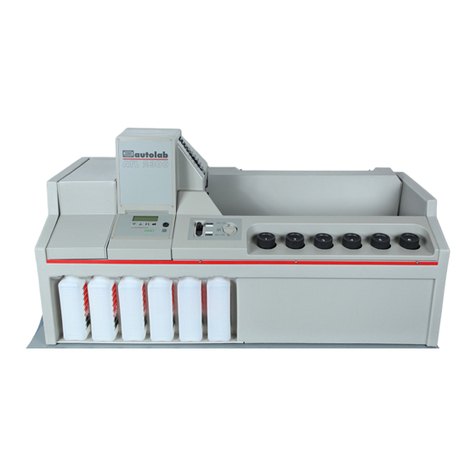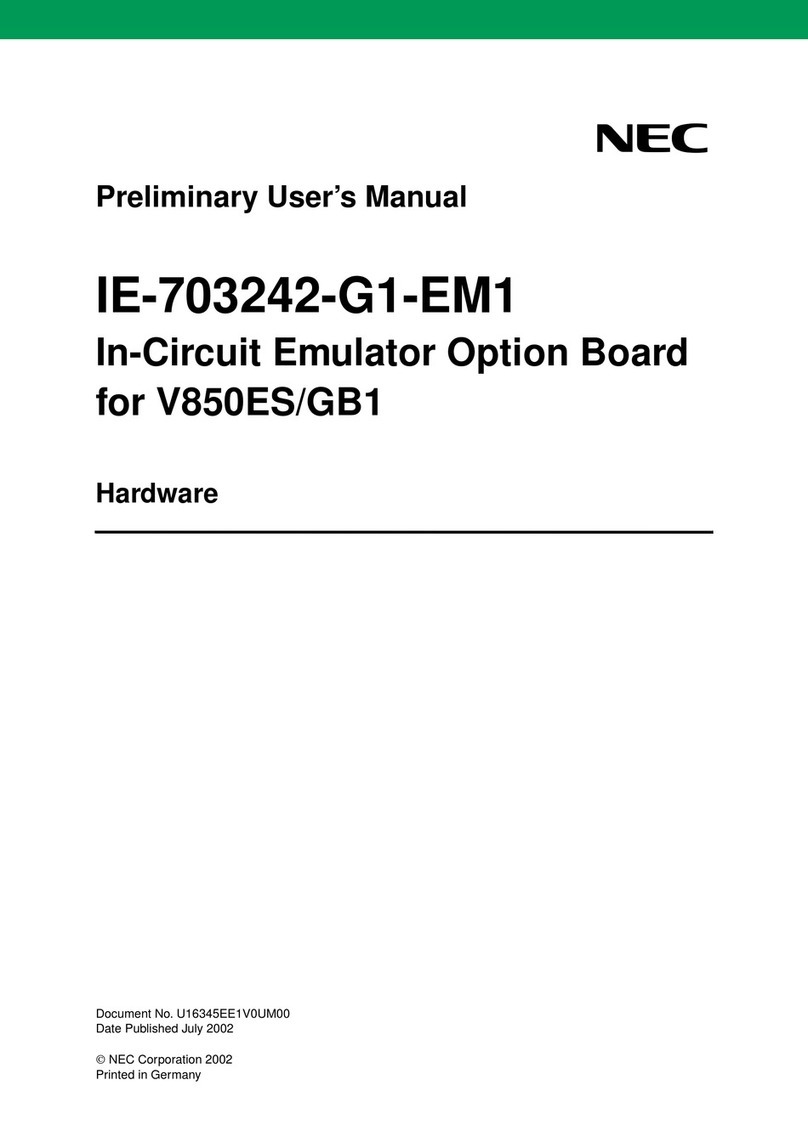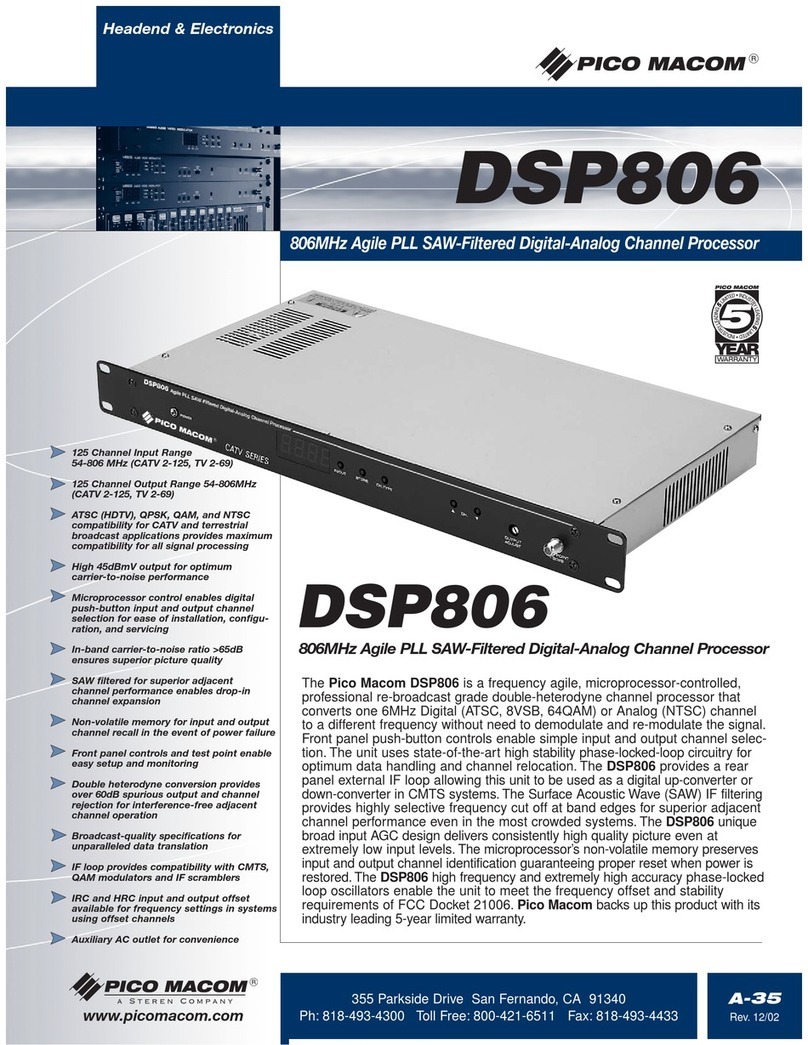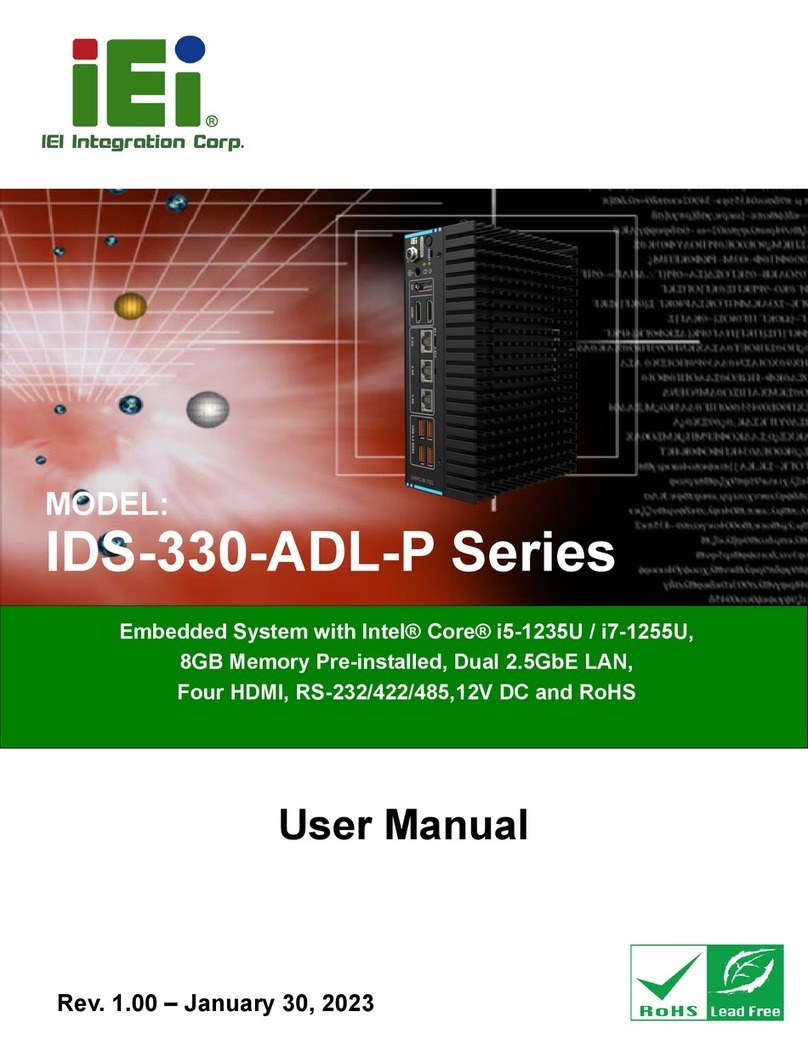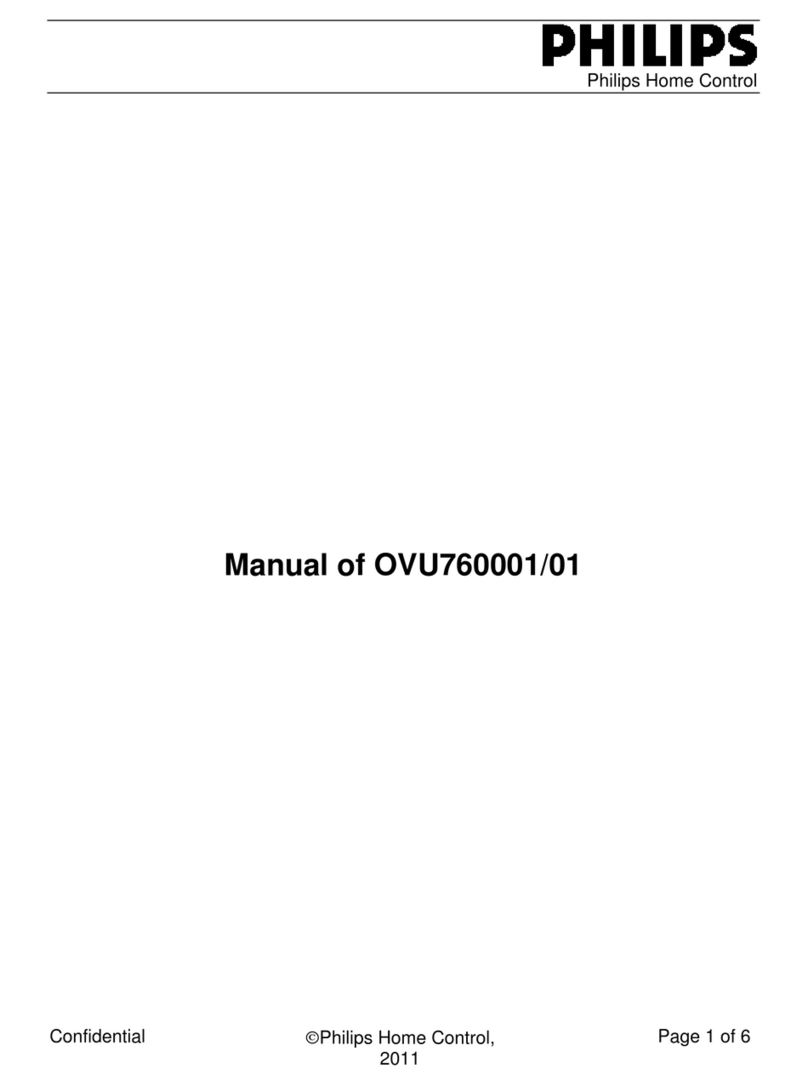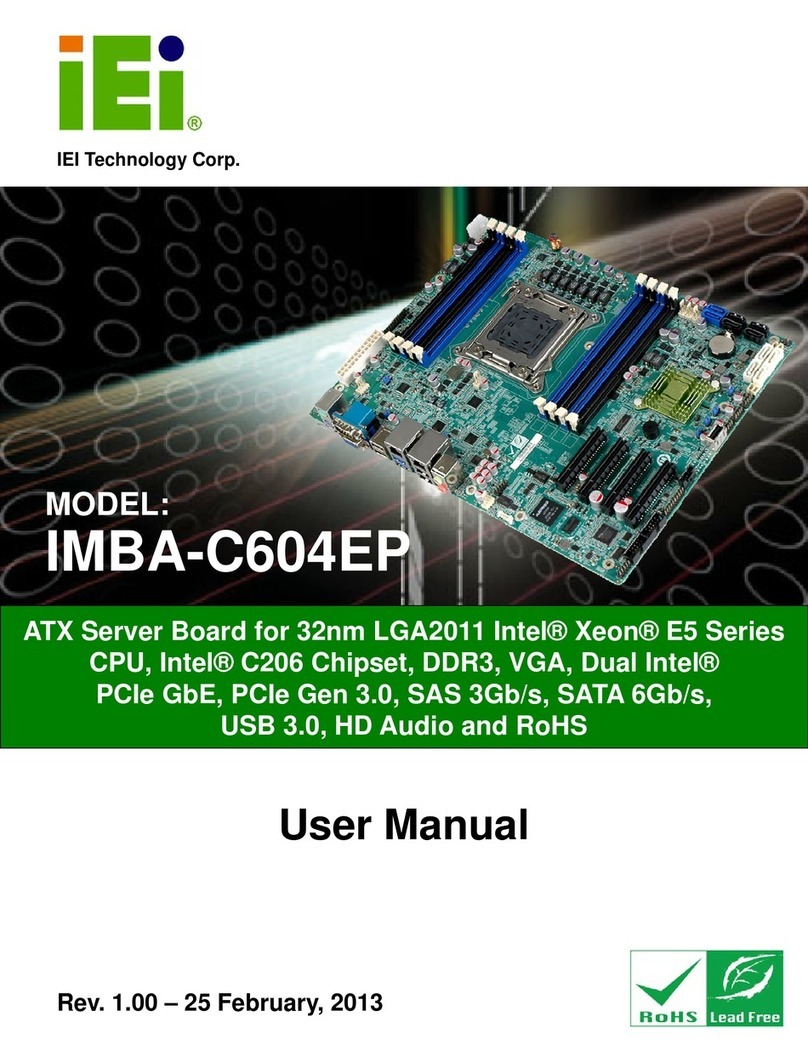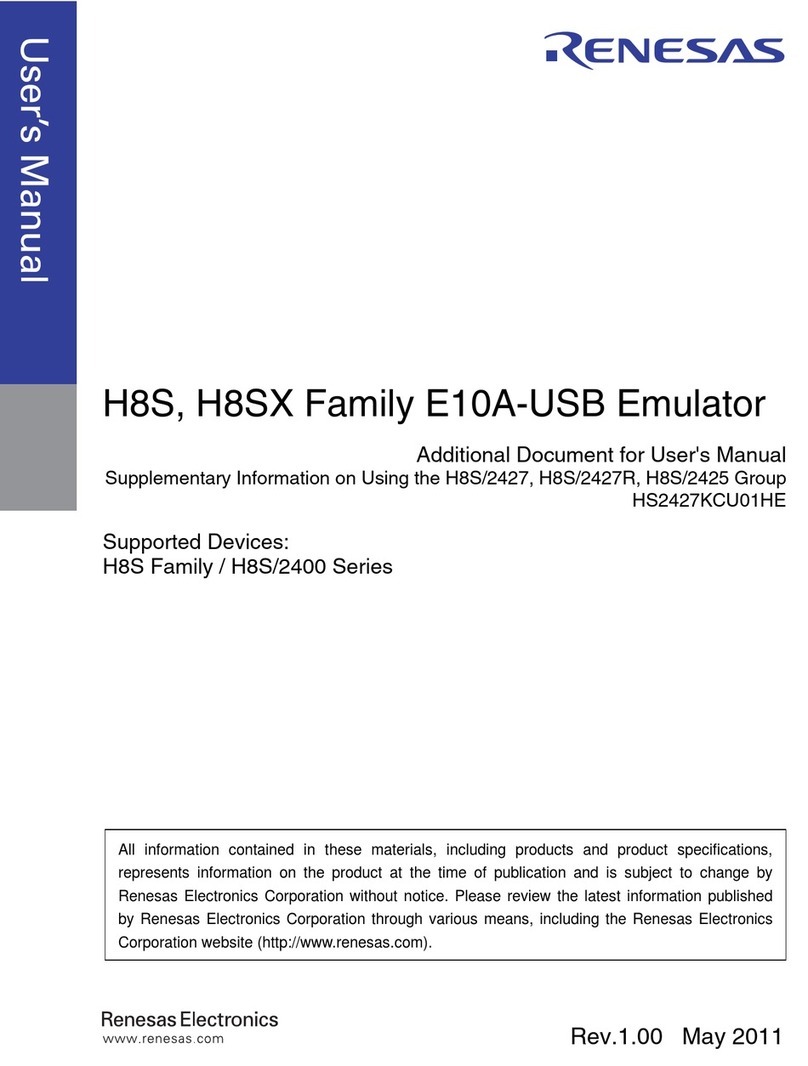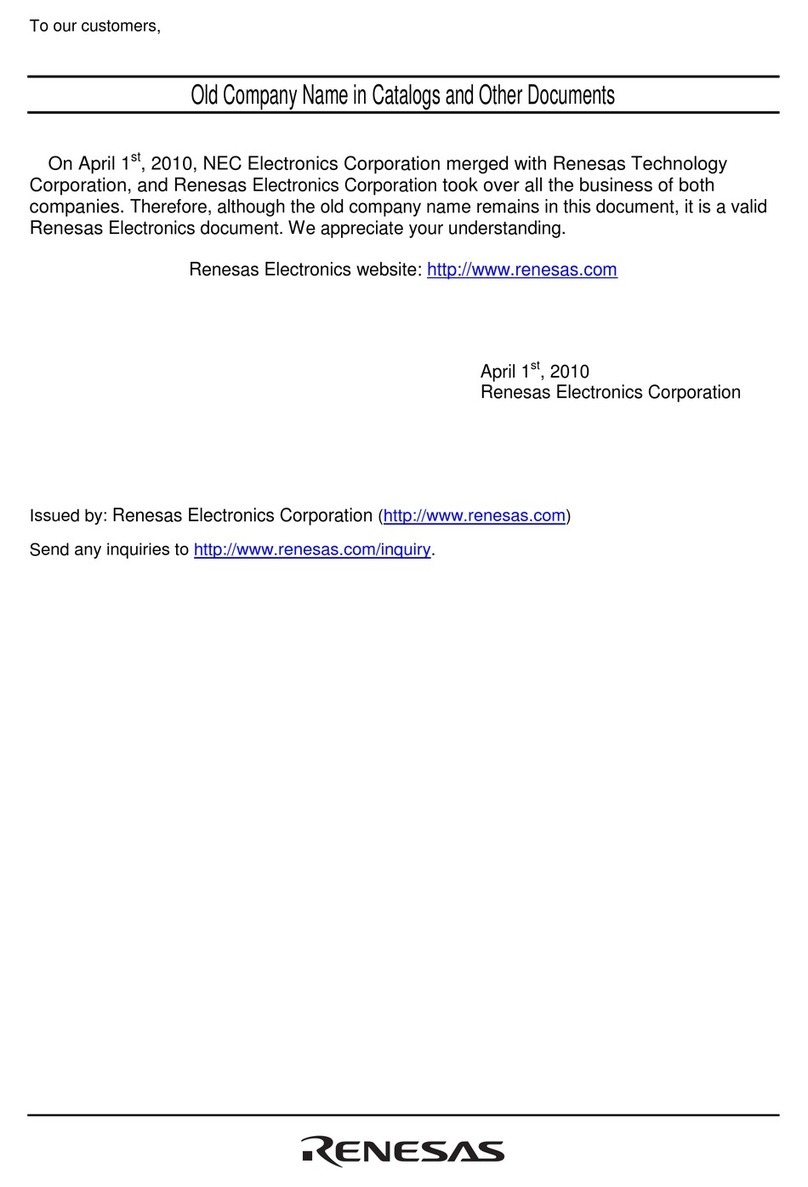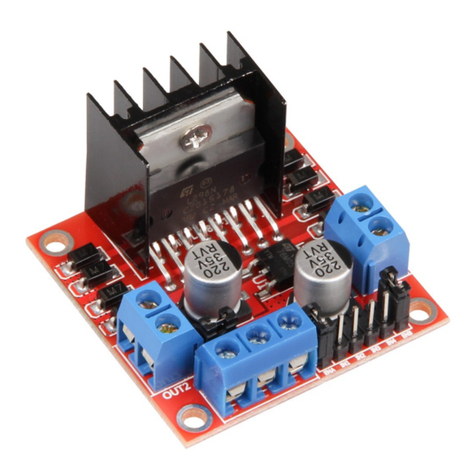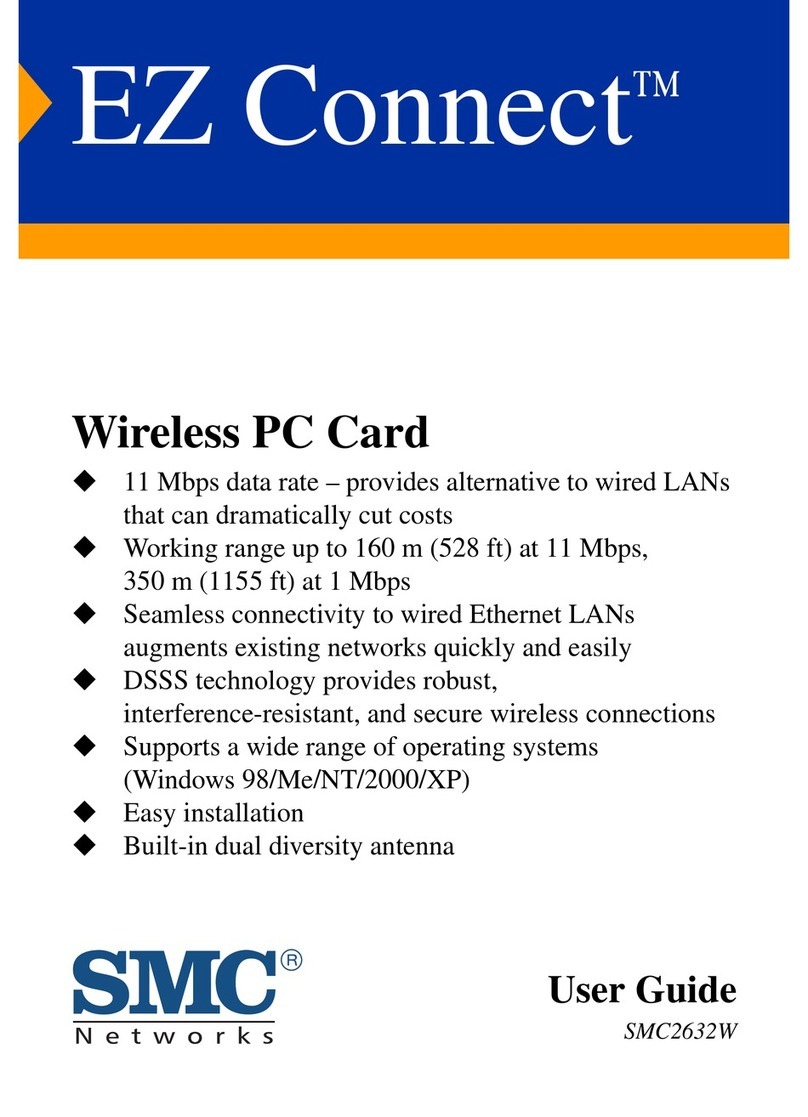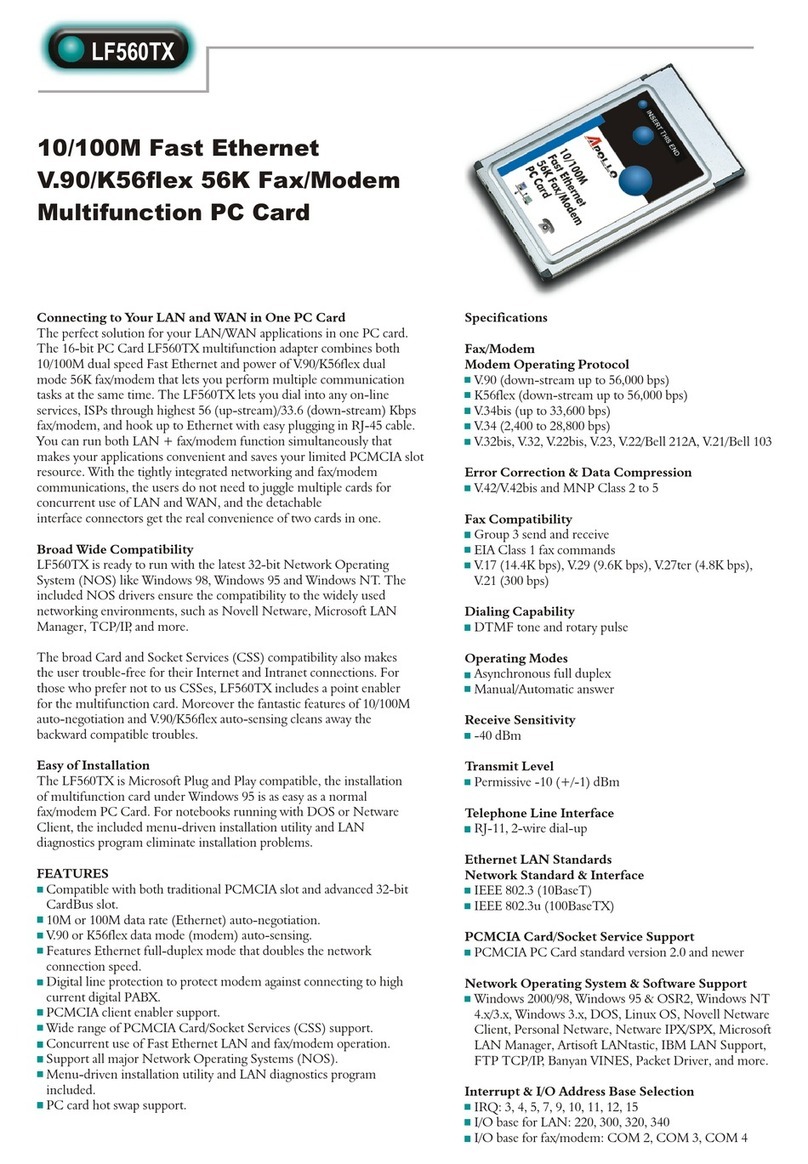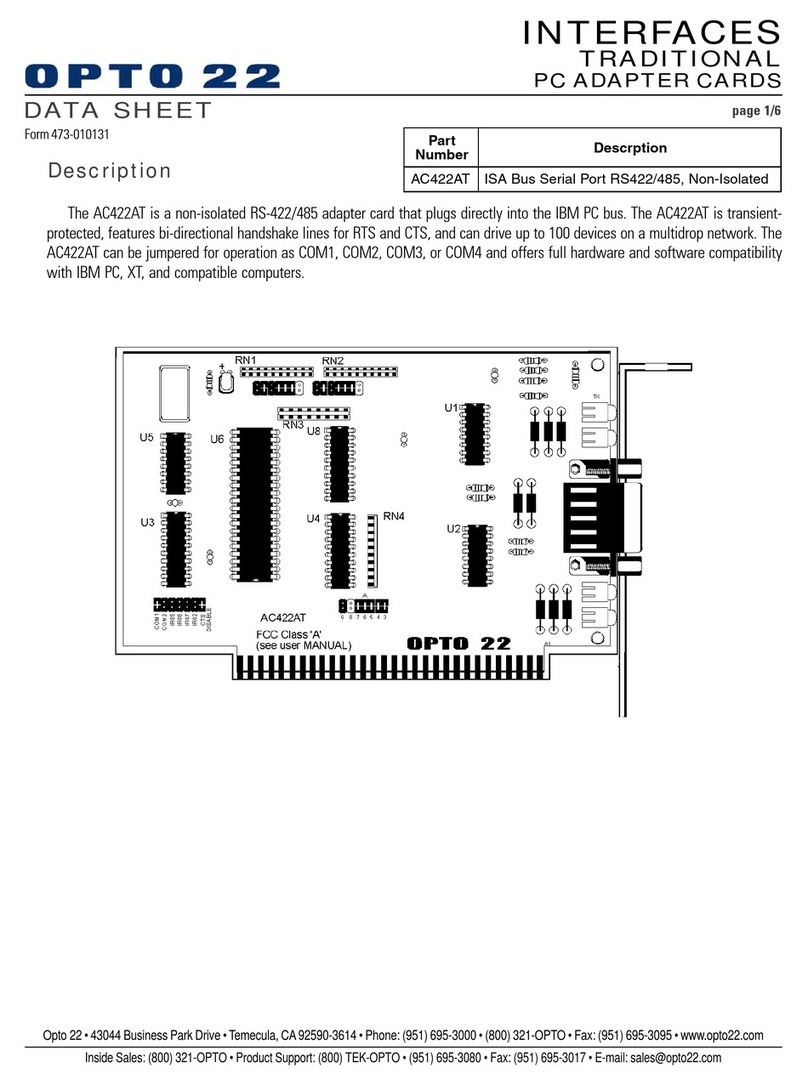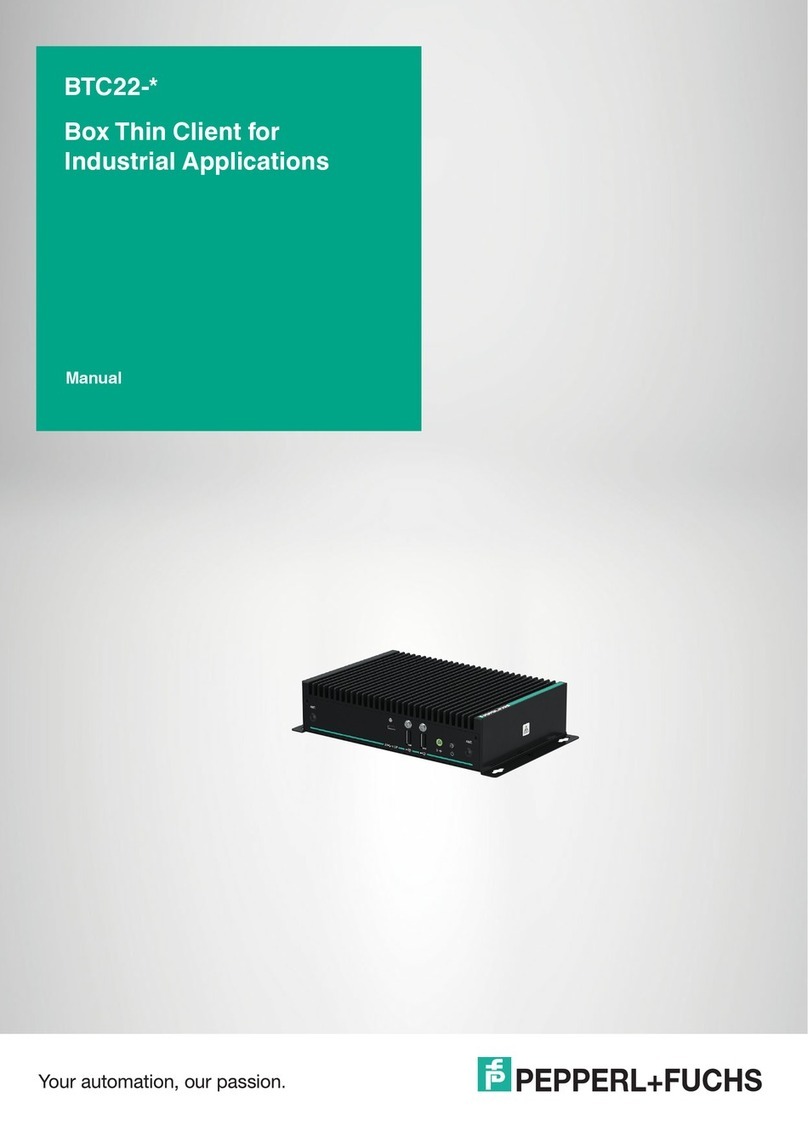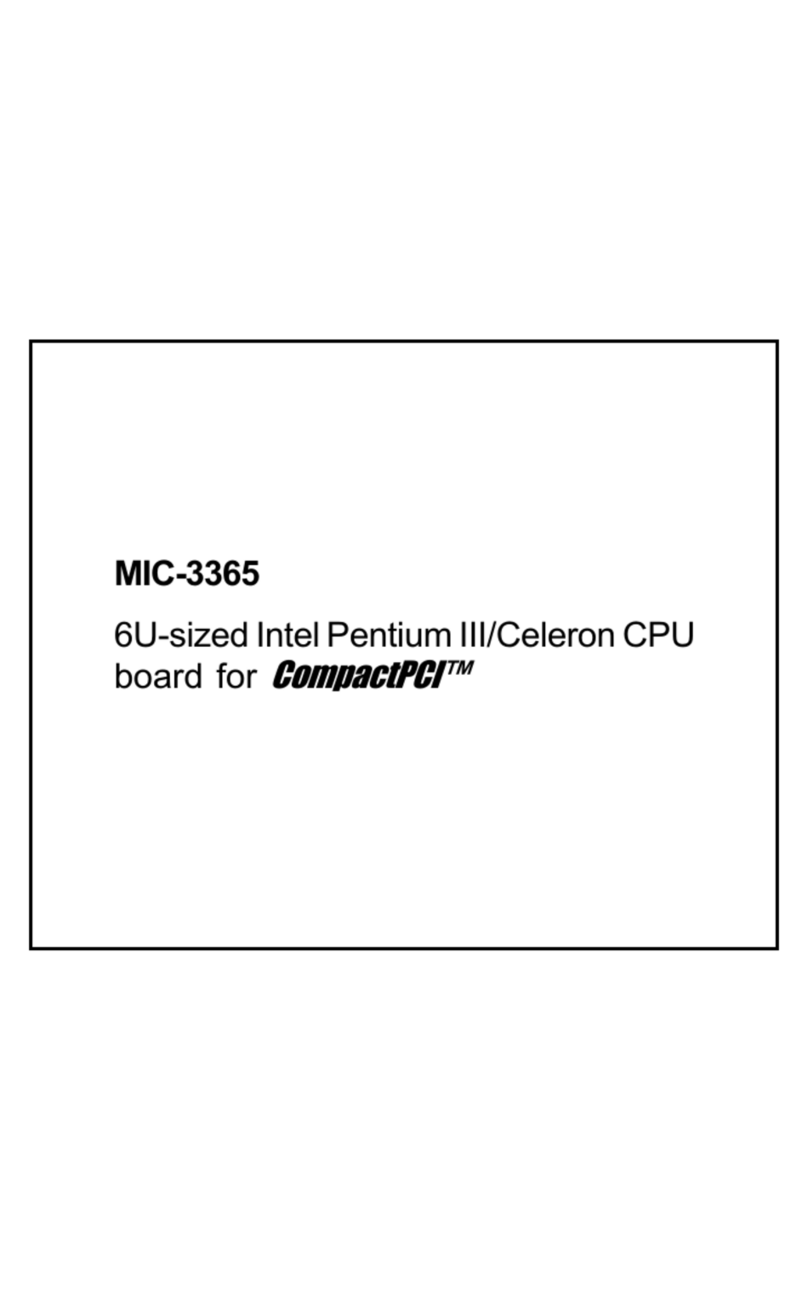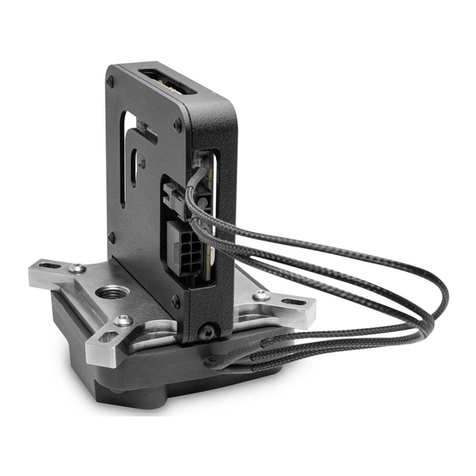BOSER Technology HS-4650 User manual

HS-4650
Socket 370 133MHz FSB
Embedded Engine Board
•CRT/Panel•133MHz FSB•PCI Slot•
•Four LAN•Audio•RS-232/422/485•
•4COM•IrDA•USB•TV-Out•H/W Monitor•
•Industrial Embedded Single Board computer•

Copyright Disclaimers
The accuracy of contents in this manual has passed thorough checking and review before
publishing. BOSER Technology Co., Ltd., the manufacturer and publisher, is not liable for
any infringements of patents or other rights resulting from its use. The manufacturer will
not be responsible for any direct, indirect, special, incidental or consequential
damages arising from the use of this product or documentation, even if advised of
the possibility of such damage(s).
This manual is copyrighted and BOSER Technology Co., Ltd. reserves all
documentation rights. Unauthorized reproduction, transmission, translation, and
storage of any form and means (i.e., electronic, mechanical, photocopying, recording)
of this document, in whole or partly, is prohibited, unless granted permission by BOSER
Technology Co., Ltd.
BOSER Technology Co., Ltd. reserves the right to change or improve the contents of
this document without due notice. BOSER Technology Co., Ltd. assumes no
responsibility for any errors or omissions that may appear in this manual, nor does
it make any commitment to update the information contained herein.
T
T
Tr
r
ra
a
ad
d
de
e
em
m
ma
a
ar
r
rk
k
ks
s
s
BOSER is a registered trademark of BOSER Technology Co., Ltd.
ISB is a registered trademark of BOSER Technology Co., Ltd.
VIA is a registered trademark of VIA Technologies, Inc.
AMI is a registered trademark of AMI Software, Inc.
All other trademarks, products and or product names mentioned herein are
mentioned for identification purposes only, and may be trademarks and/or
registered trademarks of their respective companies or owners.
© Copyright 2003 BOSER Technology Co., Ltd.
All Rights Reserved.
Edition 1.0, May 13, 2003

Table of Contents
Chapter 1 General Description ..................................1
1.1 Major Features....................................................................... 2
1.2 Specifications ........................................................................ 3
1.3 Board Dimensions................................................................. 4
Chapter 2 Unpacking ..................................................5
2.1 Opening the Delivery Package............................................. 5
2.2 Inspection............................................................................... 5
Chapter 3 Hardware Installation ..............................7
3.1 Before Installation ................................................................. 7
3.2 Board Layout ......................................................................... 8
3.3 Jumper List ............................................................................ 9
3.4 Connector List ....................................................................... 9
3.5 Configuring the CPU ........................................................... 10
3.6 System Memory ................................................................... 10
3.7 VGA Controller .................................................................... 11
3.8 PCI E-IDE Drive Connector................................................. 13
3.9 Floppy Disk Drive Connector ............................................. 15
3.10 Serial Port Connectors ....................................................... 16
3.11 Parallel Connector............................................................... 18
3.12 Ethernet Connector............................................................. 19
3.13 USB Connector.................................................................... 20
3.14 CMOS Data Clear................................................................. 20
3.15 Power and Fan Connectors................................................ 21
3.16 Keyboard and Mouse Connectors..................................... 21
3.17 System Front Panel Connectors........................................ 22
3.18 IrDA Connector.................................................................... 23
3.19 Digital I/O Connector........................................................... 23
3.20 Audio Connectors ............................................................... 24
3.21 TV Out Function .................................................................. 25
3.22 PCI Expansion Slot ............................................................. 25

Chapter 4 AMI BIOS Setup..................................... 27
4.1 Starting Setup...................................................................... 27
4.2 Using Setup ......................................................................... 28
4.3 Main Menu............................................................................ 29
4.4 Standard CMOS Setup ........................................................ 30
4.5 Advanced CMOS Setup ...................................................... 31
4.6 Advanced Chipset Setup.................................................... 32
4.7 Power Management Setup ................................................. 33
4.8 PCI / Plug and Play Setup................................................... 34
4.9 Peripheral Setup.................................................................. 35
4.10 Hardware Monitor Setup..................................................... 36
4.11 Auto-Detect Hard Disks ...................................................... 36
4.12 Change Supervisor/User Password .................................. 37
4.13 Auto Configuration with Optimal Settings ....................... 39
4.14 Auto Configuration with Fail Safe Settings...................... 40
4.15 Save Settings and Exit........................................................ 41
4.16 Exit Without Saving............................................................. 42
Chapter 5 Software Utilities..................................... 43
5.1 VIA 4 in 1 Driver Installation............................................... 43
5.2 Audio Driver Installation..................................................... 48
5.3 VGA Driver Installation ....................................................... 51
5.3.1 VGA Driver Installation for WIN98........................................................ 51
5.3.2 VGA Driver Installation for WIN NT4.0 ................................................54
5.3.3 VGA Driver Installation for WIN 2K.......................................................58
5.3.4 VGA Driver Installation for WIN XP....................................................... 61
5.4 LAN Driver Installation........................................................ 65
5.4.1 RTL8100 Driver Installation for WIN98..............................................65
5.4.2 RTL8100 Driver Installation for WIN NT4.0....................................... 70
5.4.3 82559 Driver Installation for WIN 98................................................. 81
5.4.4 82559 Driver Installation for WIN NT4.0...........................................82

Safety Instructions
Integrated circuits on computer boards are sensitive to static electricity. To
avoid damaging chips from electrostatic discharge, observe the following
precautions:
Do not remove boards or integrated circuits from their anti-static packaging
until you are ready to install them.
Before handling a board or integrated circuit, touch an unpainted portion of
the system unit chassis for a few seconds. This helps to discharge any static
electricity on your body.
Wear a wrist-grounding strap, available from most electronic component
stores, when handling boards and components. Fasten the ALLIGATOR clip
of the strap to the end of the shielded wire lead from a grounded object.
Please wear and connect the strap before handle the HS-4650 to ensure
harmlessly discharge any static electricity through the strap.
Please use an anti-static pad when putting down any components or parts or
tools outside the computer. You may also use an anti-static bag instead of
the pad. Please inquire from your local supplier for additional assistance in
finding the necessary anti-static gadgets.
NOTE: DO NOT TOUCH THE BOARD OR ANY OTHER SENSITIVE
COMPONENTS WITHOUT ALL NECESSARY ANTI-STATIC
PROTECTION.


1
Chapter 1
General Description
The HS-4650 is a 133MHz FSB VIA VT8606 chipset-based board
designed for PCI Bus Socket 370 Intel®Celeron/Coppermine/Tualatin
and VIA C3 800MHz~1.3GHz CPU. These features combine and make
the HS-4650 an ideal all-in-one industrial single board computer.
Additional features include an enhanced I/O with CRT/Panel, four LAN,
audio, 4COM ports, and TV-Out interfaces.
Its onboard ATA/33/66/100 to IDE drive interface architecture allows
the HS-4650 to support data transfers of 33, 66 or 100MB/sec. to two
IDE drive connection. Designed with the VIA VT8606 core logic
chipset, the board supports Socket 370 Intel®
Celeron/Coppermine/Tualatin and VIA C3 800MHz~1.3GHz CPU. The
VIA VT8606 integrated S3 3D supporting CRT/Panel displays up to
1920 x 1440.
System memory is also sufficient with the two DIMM sockets that can
support up to 1GB.
Additional onboard connectors include two advanced USB ports
providing faster data transmission. And four external RJ-45 connectors
for 10/100 Based Ethernet use.

2
1.1 Major Features
The HS-4650 comes with the following features:
Socket 370 for Intel®Celeron/Coppermine/Tualatin and VIA C3
800MHz~1.3GHz CPU
VIA VT8606/VT82C686B system chipset
Supports 66/100/133MHz FSB
Two DIMM sockets with a max. capacity of 1GB
SMC 37E760, VIA VT82C686B super I/O chipset
One vertical and one horizontal PCI Slots
Fast PCI ATA/33/66/100 IDE controller
Three RS-232 and one RS-232/422/485 serial ports
VIA VT8606 CRT/Panel display controller
Four RealTek RTL8100 or Intel®82559 (optional) 10/100 Based LAN
AC97 3D audio controller
Four USB connectors
Supports TV-Out function (optional)
Supports Hardware Monitor function

3
1.2 Specifications
CPU: Socket 370 for Intel®Celeron/Coppermine/Tualatin and VIA C3
800MHz~1.3GHz CPU
Bus Interface: PCI Bus
Bus Clock Rate: 66/100/133MHz FSB
Memory: Two DIMM sockets supporting up to 1GB
Chipset: VIA VT8606/VT82C686B
I/O Chipset: SMC 37E760, VIA VT82C686B
PCI Slot: Two standard PCI Slots, vertical x 1 and horizontal x 1
VGA: VIA VT8606 integrated S3 3D supporting CRT/Panel displays up
to 1920 x 1440
IDE: Four IDE disk drives supporting ATA/33/66/100 and with transfer
rates of up to 33/66/100MB/sec.
FDD: Supports up to two floppy disk drives
Parallel: One enhanced bi-directional parallel port supporting
SPP/ECP/EPP
LAN: Four RealTek RTL8100 or Intel 82559 (optional) 10/100 Based
LAN
Audio: AC97 3D audio controller
Serial Port: 16C550 UART-compatible RS-232/422/485 x 1 and RS-232
x 3 serial ports with 16-byte FIFO
IrDA: One IrDA TX/RX header
USB: Four USB connectors
TV-Out: Supports PAL or NTSC TV systems (optional)
Keyboard: PS/2 6-pin Mini DIN
Mouse: PS/2 6-pin Mini DIN
BIOS: AMI PnP Flash BIOS
CMOS: Battery backup
DMA Channels: 7
Interrupt Levels: 15
Power: Supports ATX power function
Operating Temperature: 0~+60°C
Hardware Monitor: VIA VT82C686B
Board Size: 20.33 x 14.6 cm

4
1.3 Board Dimensions

5
Chapter 2
Unpacking
2.1 Opening the Delivery Package
The HS-4650 is packed in an anti-static bag. The board has
components that are easily damaged by static electricity. Do not
remove the anti-static wrapping until proper precautions have been
taken. Safety Instructions in front of this manual describe anti-static
precautions and procedures.
2.2 Inspection
After unpacking the board, place it on a raised surface and carefully
inspect the board for any damage that might have occurred during
shipment. Ground the board and exercise extreme care to prevent
damage to the board from static electricity.
Integrated circuits will sometimes come out of their sockets during
shipment. Examine all integrated circuits, particularly the BIOS,
processor, memory modules, ROM-Disk, and keyboard controller chip
to ensure that they are firmly seated. The HS-4650 delivery package
contains the following items:
HS-4650 Board x 1
Utility CD Disk x 1
ATA/100 IDE flat cable x 1
2.0m/m IDE transfer to 2.0m/m and 2.54m/m cable x 1
FDD flat cable x 1
One RS-232 COM Port cable x 3
8-pin USB split type cable x 1
Jumper Bag x 1
User’s Manual

6
It is recommended that you keep all the parts of the delivery package
intact and store them in a safe/dry place for any unforeseen event
requiring the return shipment of the product. In case you discover any
missing and/or damaged items from the list of items, please contact
your dealer immediately.

7
Chapter 3
Hardware Installation
This chapter provides the information on how to install the hardware
using the HS-4650. This chapter also contains information related to
jumper settings of switch, jumpers and connectors.
3.1 Before Installation
After confirming your package contents, you are now ready to install
your hardware. The following are important reminders and steps to
take before you begin with your installation process.
1. Make sure that all jumper settings match their default settings
and CMOS setup correctly. Refer to the sections on this chapter
for the default settings of each jumper.
2. Go through the connections of all external devices and make
sure that they are installed properly and configured correctly
within the CMOS setup. Refer to the sections on this chapter
for the detailed information on the connectors.
3. Keep the manual and diskette in good condition for future
reference and use.

8
3.2 Board Layout
NOTE: JP10/JP11/JP14/JP15 only for Intel 82559.

9
3.3 Jumper List
Jumper
Default Setting Setting
Page
JP1~JP4 RS-232 Enabled/Disabled Select: Enabled Short 1-2 16
JP5 RS-422/485 Receiver Enabled/Disabled
Select: Disabled Short 1-2 16
JP6 RS-422/485 Transceiver Enabled/
Disabled Select: Disabled Short 1-2 16
JP7 COM2 Use RS-232 or RS-422/485 Select:
RS-232 Open 16
JP8 Panel Voltage Select: +3.3V Short 2-3 11
JP9 Clear CMOS: Normal Operation Short 1-2 20
JP10 LAN1 Enabled/Disabled Select: Enabled Short 1-2 19
JP11 LAN2 Enabled/Disabled Select: Enabled Short 1-2 19
JP12 CPU Host Clock Select: Auto Detect Open 10
JP13 CPU Host Clock Select: Auto Detect Open 10
JP14 LAN3 Enabled/Disabled Select: Enabled Short 1-2 19
JP15 LAN4 Enabled/Disabled Select: Enabled Short 1-2 19
CN19 Video/Audio Output Connector Short 1-2 25
3.4 Connector List
Connector Definition Page
CN1/CN4 USB Connector 20
CN2 PS/2 6-pin Mini DIN KB/MS Connector 21
CN3 20-pin ATX Power In Connector 21
CN5 System Front Panel Connector 22
CN6 IrDA Connector 23
CN7 COM1 Connector (DB9) 16
CN8 Digital I/O Connector 23
CN11 Dual RJ-45 Connector 19
CN10 50-pin Panel Connector 11
CN12 Video Jack Connector 25
CN13 RCA Connector 25
CN14 COM 2 Connector (5x2 header) 16
CN15 COM 3 Connector (5x2 header) 16
CN16 COM 4 Connector (5x2 header) 16
CN17 RS-422/485 Connector (5x2 header) 16
CN18 CD-In Connector 24
CN20 Line In Connector 24
. . . More on next page . . .

10
Connector Definition Page
CN21 LVDS Connector 11
DM1/DM2 168-pion DIMM Socket 10
FN1/FN2 Fan Power Connector 21
FD1 Floppy Connector 15
ID1/ID2 Primary/Secondary IDE Connectors 13
J1 MIC In/Audio Out Connector 24
LPT Parallel Connector 18
PC1/PC2 PCI Expansion Slot 25
VGA 15-pin CRT Connector 11
3.5 Configuring the CPU
The HS-4650 provides all necessary by jumper setting in using CPU
Host Clock as the system bus clocking with JP12 and JP13.
JP12, JP13: CPU Host Clock Select
Options JP12 JP13
66MHz Short Short
100MHz Open Short
133MHz (default) Open Open
The HS-4650 offers the convenience in CPU installation with its
auto-detect feature. After installing a new microprocessor onboard, the
HS-4650 automatically identifies the frequency and clock speed of the
installed microprocessor chip, thereby eliminating the need for user to
do additional CPU configuration or hardware settings related to it.
3.6 System Memory
The HS-4650 provides two DIMM sockets at locations DM1 and DM2.
The maximum capacity of the onboard memory is 1GB.

11
3.7 VGA Controller
The HS-4650 provides three connection methods of a VGA device.
VGA offers a single standard CRT connector while CN10 is the 50-pin
panel connector and CN21 is the LVDS interface connector reserved
for flat panel installation.
VGA: 15-pin CRT Connector
PIN
Description
PIN Description
1 Red 2 Green
3 Blue 4 N/C
5 GND 6 GND
7 GND 8 GND
9 N/C 10 GND
11 N/C 12 SDA
13 HSYNC 14 VSYNC
15 SCL
1
6
10
11
515
CN21: LVDS Connector
PIN
Description
PIN
Description
1 VLCD 2 VLCD
3 GND 4 GND
5 Y0M 6 Y0P
7 GND 8 Y1M
9 Y1P 10 GND
11 Y2M 12 Y2P
13 GND 14 YCM
15 YCP 16 GND
17 N/C 18 N/C
19 GND 20 GND
VLCD
GND
Y0M
GND
Y1P
Y2M
GND
YCP
N/C
GND
VLCD
GND
Y0P
Y1M
GND
Y2P
YCM
GND
N/C
GND
12
2019
NOTE: Please set the proper voltage of your panel using JP8 before
proceeding on installing it.

12
CN10: 50-pin Panel Connector
PIN.
Description
PIN
Description
1 +12V 2 +12V
3 GND 4 GND
5 3.3V / 5V Note 6 ENAVDD
7 ENAVEE 8 GND
9 PD0 10 PD1
11 PD2 12 PD3
13 PD4 14 PD5
15 PD6 16 PD7
17 PD8 18 PD9
19 PD10 20 PD11
21 PD12 22 PD13
23 PD14 24 PD15
25 PD16 26 PD17
27 PD18 28 PD19
29 PD20 30 PD21
31 PD22 32 PD23
33 PD24 34 PD25
35 FPCLKOUT 36 FPVS
37 FPDEN 38 FPHS
39 GND 40 LCDBL
41 PD26 42 PD27
43 PD28 44 PD29
45 PD30 46 PD31
47 PD32 48 PD33
49 PD34 50 PD35
12
5049
+12V
GND
3.3V/5V
ENAVEE
PD0
PD2
PD4
PD6
PD8
PD10
PD12
PD14
PD16
PD18
PD20
+12V
GND
ENAVDD
GND
PD1
PD3
PD5
PD7
PD9
PD11
PD13
PD15
PD17
PD19
PD21
PD22
PD24
FPCLKOUT
FPDEN
GND
PD26
PD28
PD30
PD32
PD34
PD23
PD25
FPVS
FPHS
LCDBL
PD27
PD29
PD31
PD33
PD35
NOTE: Please set the proper voltage of your panel using JP8 before
proceeding on installing it.
The HS-4650 has an onboard jumper that selects the working voltage
of the flat panel connected to the system. Jumper JP8 offers two
voltage settings for the user.
JP8: Panel Voltage Select
Options Settings
+5V Short 1-2
+3.3V (default) Short 2-3
3.3V/5V
13
VCC
+3.3V

13
3.8 PCI E-IDE Drive Connector
ID1 is a standard 44-pin 2.0mm pitch and ID2 is 40-pin 2.54mm pitch
connectors daisy-chain driver connector serves the PCI E-IDE drive
connection to HS-4650. A maximum of four ATA/33/66/100 IDE drives
can connect to the HS-4650 via ID1 and ID2.
ID1: Primary IDE Connector
PIN Description PIN Description
1 Reset 2 GND
3 DATA 7 4 DATA 8
5 DATA 6 6 DATA 9
7 DATA 5 8 DATA 10
9 DATA 4 10 DATA 11
11 DATA 3 12 DATA 12
13 DATA 2 14 DATA 13
15 DATA 1 16 DATA 14
17 DATA 0 18 DATA 15
19 GND 20 N/C
21 PDREQ 22 GND
23 IOW# 24 GND
25 IOR# 26 GND
27 PIORDY 28 PR1PD1-
29 RPDACK- 30 GND
31 Interrupt 32 N/c
33 RPDA1- 34 PATA 66
35 RPDA0- 36 RPDA2-
37 RPCS1- 38 RPCS3-
39 HDD Active 40 GND
41 VCC 42 VCC
43 GND 44 GND
Reset
DATA 7
DATA 6
DATA 5
DATA 4
DATA 0
GND
PDREQ
IOW#
IOR#
PIORDY
RPDACK-
Interrupt
RPDA1-
DATA 3
DATA 2
DATA 1
RPDA0-
RPCS1-
HDD ACTIVE
GND
DATA 8
DATA 9
DATA 10
DATA 11
DATA 15
N/C
GND
GND
GND
PR1PD1-
GND
N/C
PATA 66
DATA 12
DATA 13
DATA 14
RPDA2-
RPCS3-
GND
1
244
43
VCC
GND
VCC
GND

14
ID2: Secondary IDE Connector
PIN Description PIN Description
1 Reset 2 GND
3 DATA 7 4 DATA 8
5 DATA 6 6 DATA 9
7 DATA 5 8 DATA 10
9 DATA 4 10 DATA 11
11 DATA 3 12 DATA 12
13 DATA 2 14 DATA 13
15 DATA 1 16 DATA 14
17 DATA 0 18 DATA 15
19 GND 20 N/C
21 PDREQ 22 GND
23 IOW# 24 GND
25 IOR# 26 GND
27 PIORDY 28 PR1PD1-
29 RPDACK- 30 GND
31 Interrupt 32 N/C
33 RPDA1- 34 PATA 66
35 RPDA0- 36 RPDA2-
37 RPCS1- 38 RPCS3-
39 HDD Active 40 GND
Reset
DATA 7
DATA 6
DATA 5
DATA 4
DATA 0
GND
PDREQ
IOW#
IOR#
PIORDY
RPDACK-
Interrupt
RPDA1-
DATA 3
DATA 2
DATA 1
RPDA0-
RPCS1-
HDD ACTIVE
GND
DATA 8
DATA 9
DATA 10
DATA 11
DATA 15
N/C
GND
GND
GND
PR1PD1-
GND
N/C
PATA 66
DATA 12
DATA 13
DATA 14
RPDA2-
RPCS3-
GND
1
240
39
Table of contents
Other BOSER Technology Computer Hardware manuals

BOSER Technology
BOSER Technology HS-1746 User manual
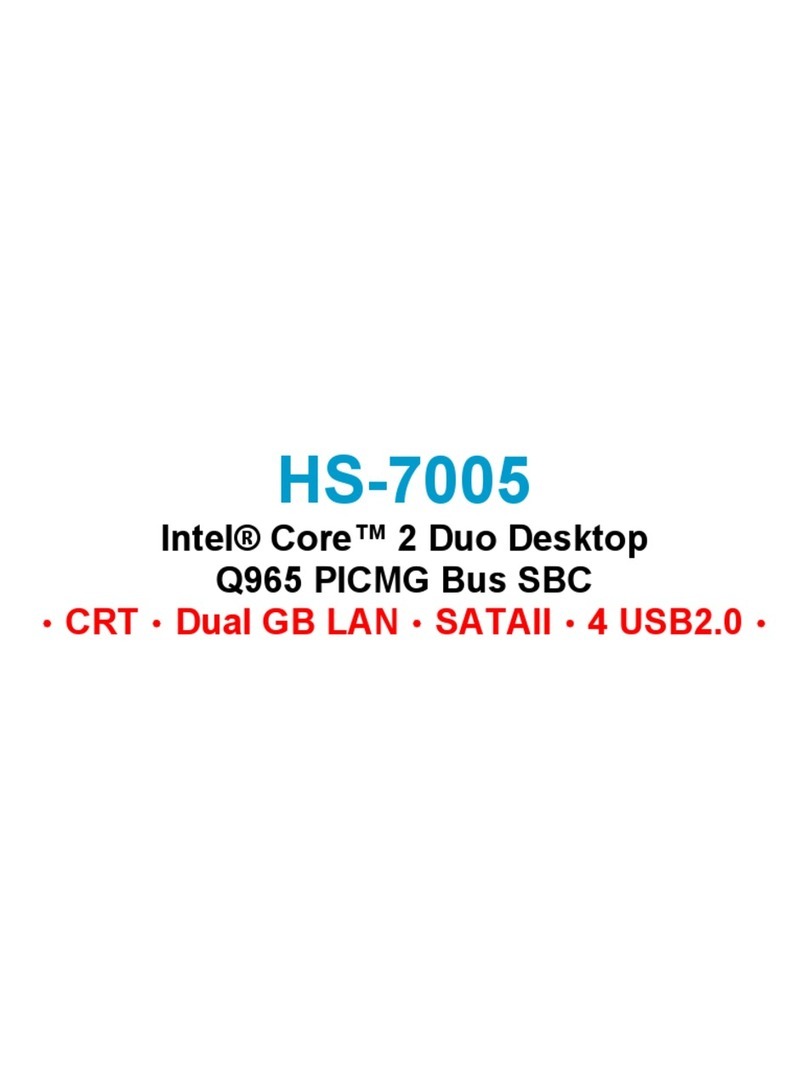
BOSER Technology
BOSER Technology HS-7005 User manual
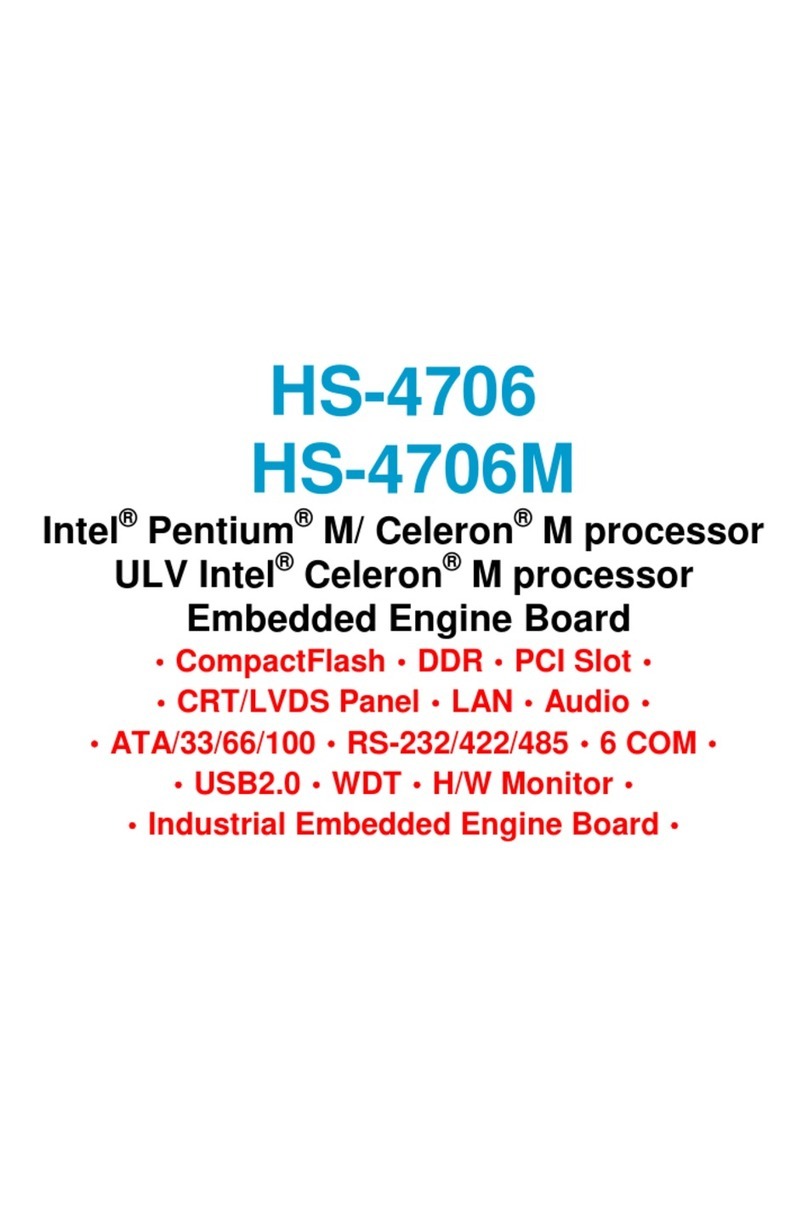
BOSER Technology
BOSER Technology HS-4706 User manual
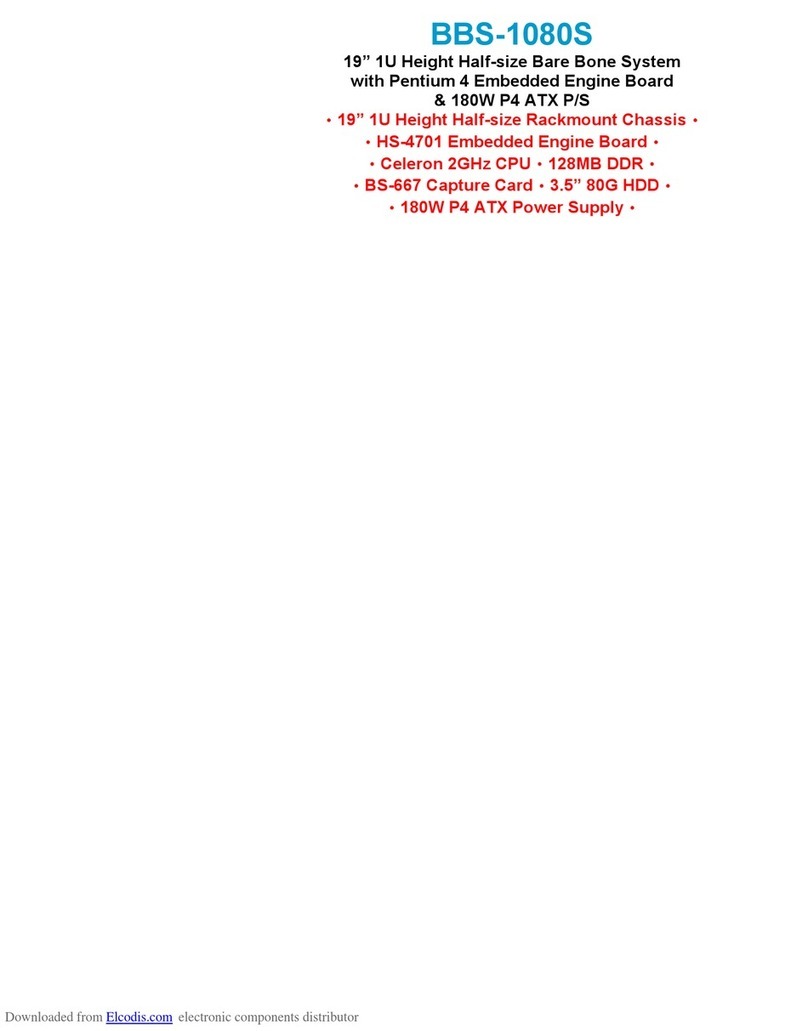
BOSER Technology
BOSER Technology BBS-1080S User manual
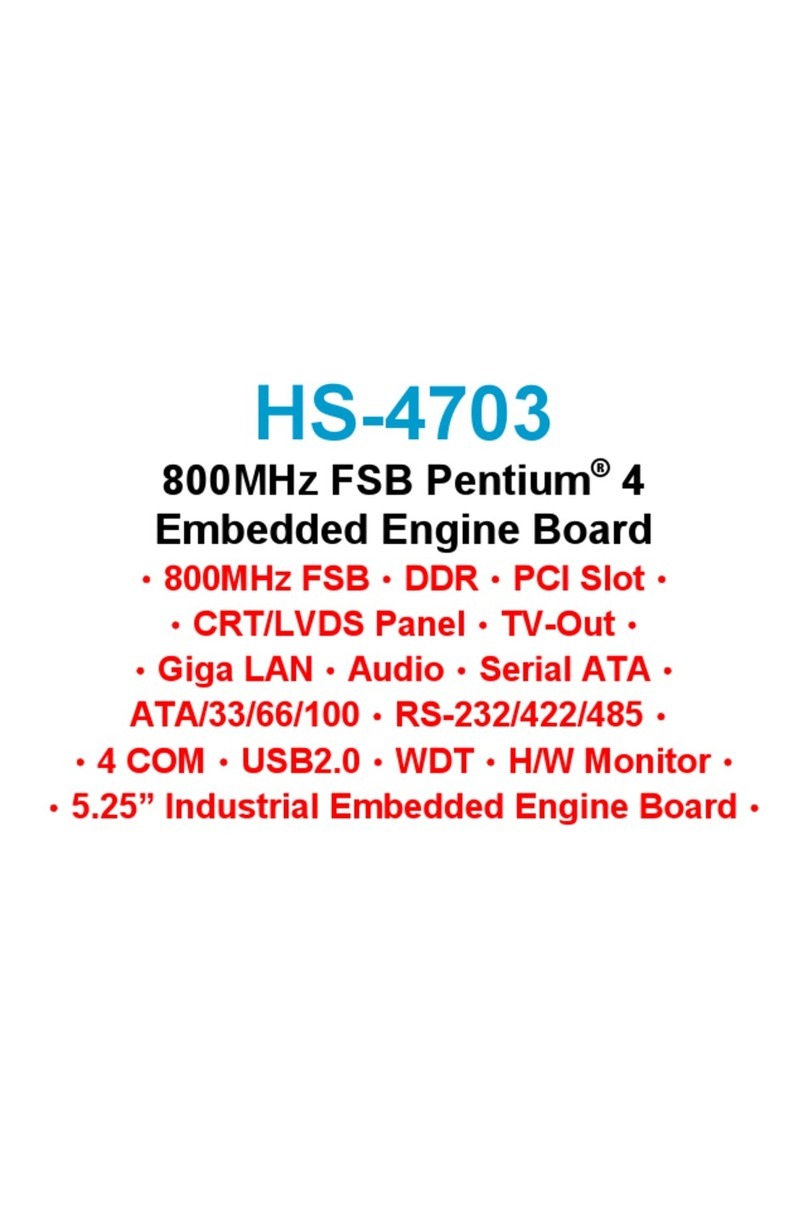
BOSER Technology
BOSER Technology HS-4703 User manual

BOSER Technology
BOSER Technology RC-741 User manual
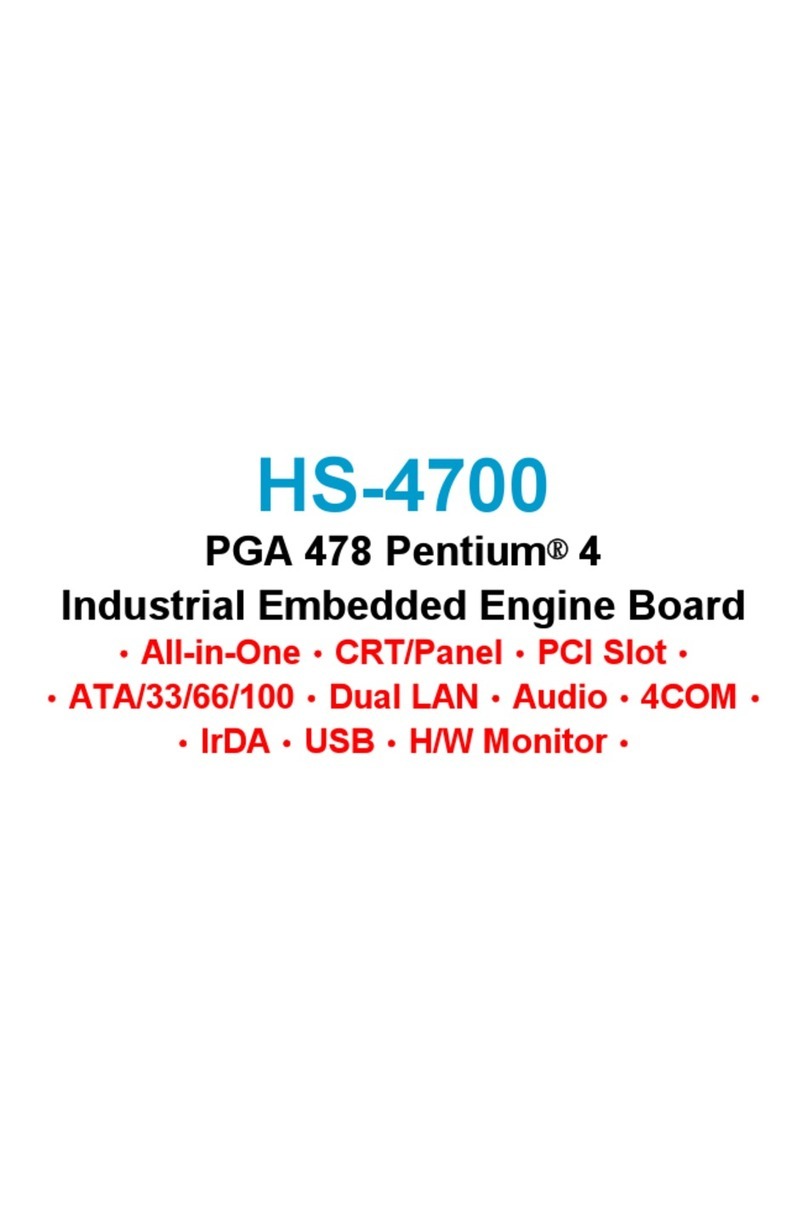
BOSER Technology
BOSER Technology HS-4700 User manual

BOSER Technology
BOSER Technology Celeron 370 User manual
